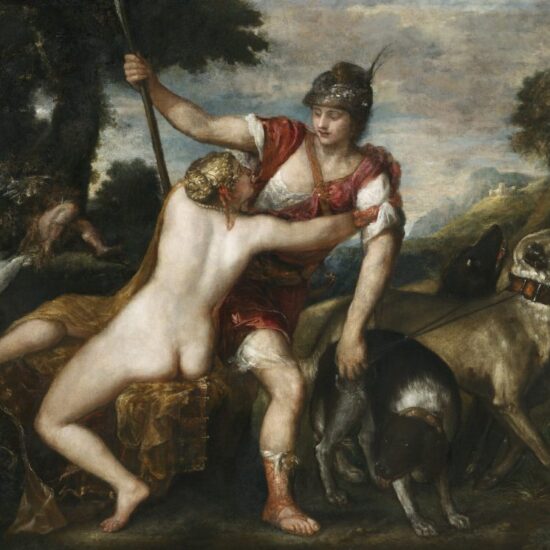Click/Tap the image to see the enlargement
Description
The subject is taken from Ovid’s Metamorphoses, a source used by Titian for the creation of paintings which he called Poesie (poems). Several of these survive of which six were sent on completion to Philip II, while the Death of Actæon (National Gallery, London) was still in the studio at Titian’s death.
Titian’s first rendition of a Venus and Adonis composition dates from 1520s and was possibly for a picture intended for Alfonso d’Este, Duke of Ferrara. He continued to develop the composition for most of his life. The fully autograph Venus and Adonis at Hatchlands was begun in preparation for the version sent to Philip (Prado, Madrid) in 1554, with many details of the composition, such as the angle of Adonis’s head, being worked out on the Hatchlands canvas. The autograph status of the Hatchlands picture is not only evident from the quality of the brushwork, but is confirmed by the nearly one hundred changes to the composition seen in x-rays (versions by studio hands generally show no or few changes). Venus and Adonis was, perhaps, Titian’s most successful secular composition, and the Hatchlands picture seems to have been used by Titian as an ever-changing-model for studio repetitions. Indeed, Titian was still fiddling with it late in life. Like the Death of Actæon it too must have been in the studio at his death.
The picture is unfinished on the left hand side, where the figure of Cupid is half obliterated by try-outs of foliage and the beginnings of a dove flying up in the air, confirms that it was in the studio at Titian’s death. It may therefore be identical with the ‘abozzatura’ (a study) of Venus and Adonis referred to by Carlo Ridolfi in 1648: ‘Some unfinished paintings [abbozzature] of Christ crowned with thorns [Munich], Christ flagellated on the column, the fable of Callisto, and that of Venus & Adonis, fell into the hands of Tintoretto’.
It later belonged to King Charles I at Whitehall Palace and was bought at the Commonwealth sales by a parliamentarian Captain Robert Mallory in November 1649 for £25. By 1768 it was at Rokeby Hall, Yorkshire, hanging in the same room as the famous Velazquez, The Rokeby Venus (now National Gallery, London).
